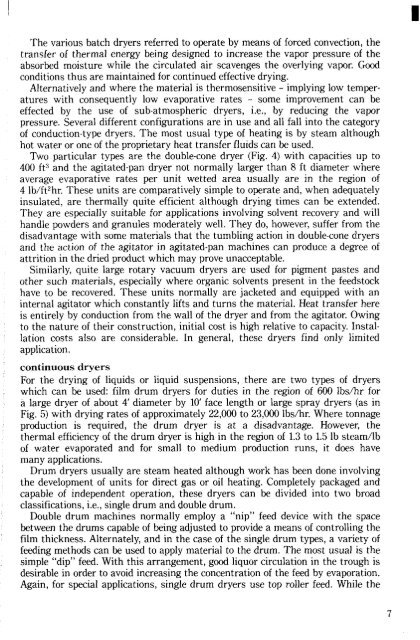Create successful ePaper yourself
Turn your PDF publications into a flip-book with our unique Google optimized e-Paper software.
The various batch dryers referred to operate by means of forced convection, the<br />
transfer of thermal energy being designed to increase the vapor pressure of the<br />
absorbed moisture while the circulated air scavenges the overlying vapor. Good<br />
conditions thus are maintained for continued effective drying.<br />
Alternatively and where the material is thermosensitive - implying low temperatures<br />
with consequently low evaporative rates - some improvement can be<br />
effected by the use of sub-atmospheric dryers, Le., by reducing the vapor<br />
pressure. Several different configurations are in use and all fall into the category<br />
of conduction-type dryers. The most usual type of heating is by steam although<br />
hot water or one of the proprietary heat transfer fluids can be used.<br />
Two particular types are the double-cone dryer (Fig. 4) with capacities up to<br />
400 ft3 and the agitated-pan dryer not normally larger than 8 ft diameter where<br />
average evaporative rates per unit wetted area usually are in the region of<br />
4 lb/ft2hr. These units are comparatively simple to operate and, when adequately<br />
insulated, are thermally quite efficient although drying times can be extended.<br />
They are especially suitable for applications involving solvent recovery and will<br />
handle powders and granules moderately well. They do, however, suffer from the<br />
disadvantage with some materials that the tumbling action in double-cone dryers<br />
and the action of the agitator in agitated-pan machines can produce a degree of<br />
attrition in the dried product which may prove unacceptable.<br />
Similarly, quite large rotary vacuum dryers are used for pigment pastes and<br />
other such materials, especially where organic solvents present in the feedstock<br />
have to be recovered. These units normally are jacketed and equipped with an<br />
internal agitator which constantly lifts and turns the material. Heat transfer here<br />
is entirely by conduction from the wall of the dryer and from the agitator. Owing<br />
to the nature of their construction, initial cost is high relative to capacity. Installation<br />
costs also are considerable. In general, these dryers find only limited<br />
application.<br />
continuous dryers<br />
For the drying of liquids or liquid suspensions, there are two types of dryers<br />
which can be used: film drum dryers for duties in the region of 600 lbs/hr for<br />
a large dryer of about 4’ diameter by 10’ face length or large spray dryers (as in<br />
Fig. 5) with drying rates of approximately 22,000 to 23,000 lbs/hr. Where tonnage<br />
production is required, the drum dryer is at a disadvantage. However, the<br />
thermal efficiency of the drum dryer is high in the region of 1.3 to 1.5 lb steam/lb<br />
of water evaporated and for small to medium production runs, it does have<br />
many applications.<br />
Drum dryers usually are steam heated although work has been done involving<br />
the development of units for direct gas or oil heating. Completely packaged and<br />
capable of independent operation, these dryers can be divided into two broad<br />
classifications, i.e., single drum and double drum.<br />
Double drum machines normally employ a “nip” feed device with the space<br />
between the drums capable of being adjusted to provide a means of controlling the<br />
film thickness. Alternately, and in the case of the single drum types, a variety of<br />
feeding methods can be used to apply material to the drum. The most usual is the<br />
simple “dip” feed. With this arrangement, good liquor circulation in the trough is<br />
desirable in order to avoid increasing the concentration of the feed by evaporation.<br />
Again, for special applications, single drum dryers use top roller feed. While the<br />
7



